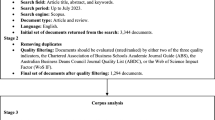Abstract
In this paper, we present a new approach to model coupling that probably forms the methodological basis of a new generation of Integrated Assessment models. This approach respects the knowledge and expertise that is embodied in existing models and encourages their gradual evolution. Modularity is the guiding principle. Our approach is distinguished by the way modules are coupled which is based on an interplay of a job control module, a numerical coupling module, and a couple of stand-alone functional modules. The numerical coupling module - the core component - serves to treat the feedbacks between the functional modules. A first implemented example that couples an economic and a climate module by means of a two-phase meta-optimization is presented here. The algorithm and mathematical structure behind are discussed as well as important features such as convergence behavior and reliability.
Similar content being viewed by others
References
J.F. Reynolds B. Acock (1997) ArticleTitleModularity and genericness in plant and ecosystem models Ecological Modelling 94 7–16
M.J. Janssen (1998) Modelling Clobal Change: The Art of Integrated Asessment Modelling Edward Elgar Celtenham
J. Rotmans H. Dowlatabadi (1998) Integrated assessment modeling S. Rayner E. Malone (Eds) Human Choice and Climate Change Tools for Policy Analysis Batelle Press Columbus 291–377
J. Rotmans M.B.A. Asselt Particlevan (1996) ArticleTitleIntegrated assessment: a growing child on its way to maturity Climatic Change 34 327–336
S.H. Schneider (1997) ArticleTitleIntegrated assessment modeling of global climate change: transparent rational tool for policymaking or opaque screen hiding value-laden assumptions? Environmental Modeling and Assessment 2 229–248
W.D. Nordhaus (1994) Managing the Global Commons MIT Press Cambridge
J. Alcamo (1994) IMAGE 2.0 - Integrated Modeling of Global Climate Change Kluwer Dordrecht
S. Messner L. Schrattenholzer (2000) ArticleTitleMESSAGE-MACRO: linking an energy supply model with a macroeconomic module and solving it iteratively Energy 25 267–282
P.S. Gaertner (2001) ArticleTitleOptimisation analysis and integrated models of the enhanced greenhouse effect Environmental Modelling and Assessment 6 7–34
C. Jaeger M. Leimbach C. Carraro K. Hasselmann J.C. Hourcade A. Keeler R. Klein (2002) Community integrated assessment: modules for cooperation SeriesTitleWorking Paper, FEEMNota di Lavoro NumberInSeries53.2002 Fondazione Eni Enrico Mattei Milan
H.J. Schellnhuber, R. Warren, A. Haxeltine and L. Naylor, Developments in integrated assessment: the co-productive approach, in: Proceedings of OECD Workshop on Benefits of Climate Policy, December 2002, Paris, in press.
M.J. Janssen (1996) Meeting targets: tools to support integrated assessment modelling of global change CIP-Gegevens Koninklijke Bibliotheek Den Haag
D.G. Luenberger (1969) Optimization by Vector Space Methods Wiley New York
R. Caballero T. Gomez M. Luque F. Miguel F. Ruiz (2002) ArticleTitleHierarchical generation of Pareto optimal solutions in large-scale multiobjective systems Computers & Operations Research 29 1537–1558
G.B. Dantzig P. Wolfe (1960) ArticleTitleDecomposition principle for linear programs Operations Research 8 101–111 Occurrence Handle10.1287/opre.8.1.101
J.F. Shapiro (1979) Mathematical Programming: Structures and Algorithms Wiley New York
M.G. Singh (1980) Dynamical Hierarchical Control North-Holland Amsterdam
O. Bahn A. Haurie S. Kypreos J.-P. Vial (1998) ArticleTitleAdvanced mathematical programming modeling to assess the benefits from international CO2 abatement cooperation Environmenmtal Modeling and Assessment 3 107–115
O. Bahn A. Haurie S. Kypreos J.-P. Vial (1996) A decomposition approach to multiregional environmental planning: a numerical study C. Carraro A. Haurie (Eds) Operations Research and Environmental Management Kluwer Dordrecht 119–132
P.B. Dixon (1975) The Theory of Joint Maximization North-Holland Amsterdam
F.L. Toth T. Bruckner H.-M. Fuessel M. Leimbach G. Petschel-Held (2003) ArticleTitleIntegrated asessment of long-term climate policies: Part 1 -Model presentation Climatic Change 56 37–56
M. Leimbach T. Bruckner (2001) ArticleTitleInfluence of economic constraints on the shape of emission corridors Computational Economics 18 173–191
T. Bruckner G. Hooss H.-M. Fuessel K. Hasselmann (2003) ArticleTitleClimate system modeling in the framework of the tolerable Windows approach: The ICLIPS climate model Climatic Change 56 119–137 Occurrence Handle1:CAS:528:DC%2BD3sXjs1WisQ%3D%3D
M. Leimbach F.L. Toth (2003) ArticleTitleEconomic development and emission control over the long term: the ICLIPS aggregated economic model Climatic Change 56 139–165 Occurrence Handle1:CAS:528:DC%2BD38Xpt1aksLY%3D
A. Stolbjerg Drud Leon Lasdon (1997) Nonlinear programming T. Gal H.J. Greenberg (Eds) Advances in Sensitivity Analysis and Parametric Programming Kluwer Boston 10–14
D.G. Luenberger (1984) Introduction to Linear and Non-linear Programming Addison-Wesley Menlo Park
A. Brooke D. Kendrick A. Meeraus (1992) GAMS - A User’s Guide, Release 2.25 The Scientific Press San Francisco
A. Stolbjerg Drud (1994) ArticleTitleCONOPT - A large-scale GRG code ORSA Journal on Computing 6 207–216
T.M.L. Wigley S.C.B. Raper (1987) ArticleTitleThermal expansion of sea water associated with global warming Nature 330 127–131
T.M.L. Wigley S.C.B. Raper (1992) ArticleTitleImplication for climate and sea level of revised IPCC emissions scenarios Nature 357 293–300 Occurrence Handle1:CAS:528:DyaK38XktlSrtb8%3D
T.M.L. Wigley S.C.B. Raper S. Smith M. Hulme (2000) The MAGICC/SCENGEN Climate Scenario Generator: Version 2.4: Technical Manual Climatic Research Unit, UEA Norwich
IPCC, Climate Change 2001: The Scientific Basis, Contribution of Working Group I to the Third Assessment Report of the Intergovernmental Panel on Climate Change (Cambridge University Press, 2001).
Author information
Authors and Affiliations
Corresponding author
Rights and permissions
About this article
Cite this article
Leimbach, M., Jaeger, C. A modular approach to Integrated Assessment modeling. Environ Model Assess 9, 207–220 (2005). https://doi.org/10.1007/s10666-005-2361-5
Issue Date:
DOI: https://doi.org/10.1007/s10666-005-2361-5




